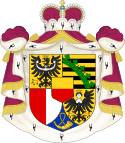|
1939 Liechtenstein general election
General elections were held in Liechtenstein on 4 April 1939.[1] Although a new system of proportional representation had been introduced to pacify voters at a time when the country was under threat from neighbouring Nazi Germany, it was not used and the elections became known as the "silent elections" as no actual vote was held.[2] Instead, the governing Progressive Citizens' Party and opposition Patriotic Union formed a coalition, assigning a roughly equal number of seats each, in order to prevent the German National Movement in Liechtenstein from acquiring any seats in the Landtag.[2][3] BackgroundOn 31 March 1938, in the wake of the Anschluss of Austria, Franz I made his grandnephew Franz Joseph II regent and moved to Feldberg, Czechoslovakia. On 25 July, Franz died while at one of his family's castles, Castle Feldberg, and Franz Joseph formally succeeded him as prince of Liechtenstein as Franz Joseph II.[4][5] Around the same time, the German National Movement in Liechtenstein (VDBL), a local Liechtenstein Nazi party, was formed and advocated for the annexation of Liechtenstein into Nazi Germany.[6] Under the initiative of Franz Joseph, the Progressive Citizens' Party (FBP) and Patriotic Union started negotiations for the formation of a coalition government.[7][8] This coalition was designed to avoid political deadlock while there was ongoing threat from Nazi Germany.[9][7] As a result of the coalition, Deputy Prime Minister of Liechtenstein, Anton Frommelt, a member of the Progressive Citizens' Party, was succeeded by Alois Vogt of the Patriotic Union.[10][11] In addition, prime minister Josef Hoop's second cabinet was succeeded by a new cabinet, now containing several members of both parties as per the coalition agreement.[12] A compromise in the coalition agreement was to introduce a proportional representation to the country, despite it being rejected via referendum three years prior.[13][14] It was introduced unanimously on 18 January 1939.[13][15] On 11 March 1939 Franz Joseph, in agreement with both parties, disbanded the Landtag and called for early elections.[3] The elections were only used to distribute a roughly equal number of seats in the Landtag between the two parties, as such it became known as the "silent election" as no actual voting took place.[2] This was allowed to due to article thirty of the new proportional representation law, which allows for one or more parties, representing at least 80% of the vote share in the previous election to propose a joint list of candidates, and for them to be declared elected while excluding other parties.[15] The clause was enacted due to both parties' desire to not hold an election campaign period that would jeopardize the recently formed coalition government and allow for the VDBL to be able to gain support.[3] On 24 March 1939 a putsch took place, where approximately 40 members of the VDBL starting from Nendeln marched towards Vaduz, planning to provoke a clash between them and the government. German troops from Feldkirch would then move into Liechtenstein in response to a call for help and incorporate the country into Germany. Further coup participants were supposed to close the Triesen-Balzers road and the Vaduz-Sevelen Rhine bridge in the wake of the German invasion, though this did not happen as it was blocked on Adolf Hitler's orders after intervention by Alois Vogt.[16][17] The plan failed however, as they were stopped by opponents, and most VDBL members were arrested or fled. The coup was unpopular with most people in Liechtenstein and it generated a strong sense of patriotic unity.[16] This caused the Liechtenstein Loyalty Association, which had been founded months prior, to heighten its operations against the VDBL and launch a signature campaign to reaffirm Liechtenstein's independence, which received 2492 signatures.[18][19] The scheduled elections is believed to be the primary motivation for the coup, as many within the VDBL saw it as a last hope to gaining power within the country.[20] The election process could have been challenged and been made a subject via referendum, which would have required at least 400 signatures to force an open ballot election.[3] However, this did not happen, and on 6 April the results – a predetermined list of candidates from both parties – were announced.[3] ResultsThe Progressive Citizens' Party maintained its majority in the Landtag and Josef Hoop remained Prime Minister. However, both the FBP and VU now held a roughly equal number of seats.[12] This coalition between the two parties lasted until 1997.[7]
By electoral district
References
Bibliography
|
|||||||||||||||||||||||||||||||||||||||||||||||||||||||||||||||||||||||||||||||||||||||||||||||||||||||||||||||||||||||||


